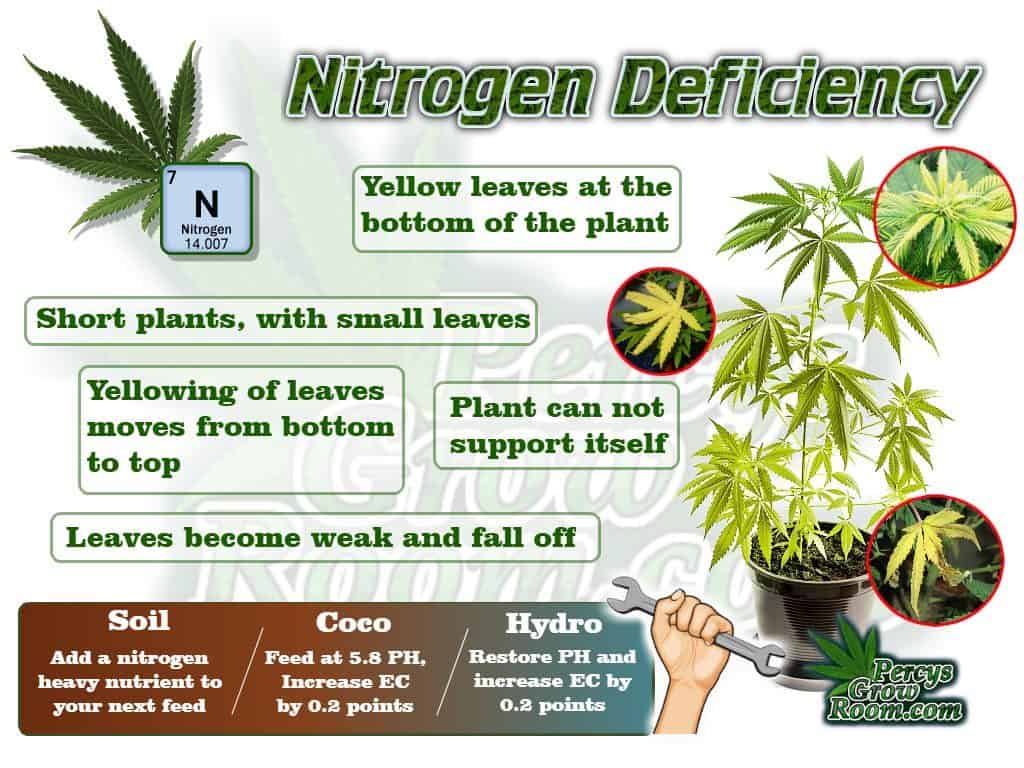Introduction
In the realm of cannabis cultivation, nitrogen deficiency stands as a common ailment that can hinder the growth and productivity of your precious plants. Nitrogen, an essential macronutrient, plays a vital role in various physiological processes, including photosynthesis, amino acid synthesis, and chlorophyll production. When nitrogen levels fall below optimal, your weed plants suffer, displaying telltale signs that call for immediate intervention.

Image: www.mycannabis.com
Recognizing Nitrogen Deficiency
The first step towards rectifying nitrogen deficiency lies in accurately identifying its symptoms. A keen eye and prompt action can save your plants from severe setbacks. Observe the following telltale signs:
-
Yellowing or Chlorosis: Nitrogen deficiency manifests visually through yellowing leaves, starting from the older ones at the bottom of the plant. As the condition progresses, yellowing spreads upwards, eventually encompassing the entire plant.
-
Stunted Growth: Insufficient nitrogen inhibits cell division and growth, resulting in stunted growth and underdeveloped plants. The internodes between leaf sets become shorter, and overall plant height remains diminutive.
-
Reduced Yield: Nitrogen shortage directly impacts bud development, reducing yield and compromising the quality of your harvest. Flowers may be sparse, underdeveloped, or even fail to form entirely.
Immediate Remedies for Nitrogen Deficiency
Timely action is crucial when addressing nitrogen deficiency in your weed plants. Implement these measures swiftly to prevent further damage and restore plant health:
-
Supplemental Nitrogen: The most straightforward approach involves providing additional nitrogen to the affected plants. Apply a nitrogen-rich fertilizer, such as fish emulsion or urea, following the recommended dosage. Foliar feeding, where fertilizer is applied directly to the leaves, can deliver a quick boost.
-
Compost and Organic Matter: Incorporating organic matter, such as compost or manure, into the soil gradually releases nitrogen over time. This method is beneficial for sustained nitrogen supply and improved soil health.
-
Nitrogen-Fixing Bacteria: Certain bacteria, known as nitrogen-fixing bacteria, have the ability to convert atmospheric nitrogen into a form usable by plants. Introducing these bacteria into the rhizosphere, the area around the plant’s roots, can enhance nitrogen availability.
Long-Term Prevention of Nitrogen Deficiency
While addressing nitrogen deficiency is crucial, implementing proactive measures can prevent future occurrences. Consider these long-term strategies:
-
Soil Testing: Regular soil testing provides valuable insights into nitrogen levels and other soil parameters. This information guides informed fertilization decisions, ensuring optimal nitrogen availability.
-
Companion Planting: Companion planting, the practice of growing nitrogen-fixing plants alongside weed plants, can naturally enrich the soil with nitrogen. Legumes, such as clover and alfalfa, are excellent choices for this purpose.
-
Mulching and Cover Crops: Mulching with organic materials and planting cover crops help maintain soil organic matter levels, supporting slow nitrogen release and soil fertility.

Image: percysgrowroom.com
How To Fix Nitrogen Deficiency In Weed Plants
Conclusion
Nitrogen deficiency in weed plants is a common yet avoidable issue that can be effectively managed with timely intervention and proactive measures. By recognizing the symptoms, addressing the deficiency promptly, and implementing preventive strategies, you can ensure the health and productivity of your cannabis plants. Remember to consult with experienced growers or seek professional advice if needed to optimize nitrogen management and maximize your harvest.